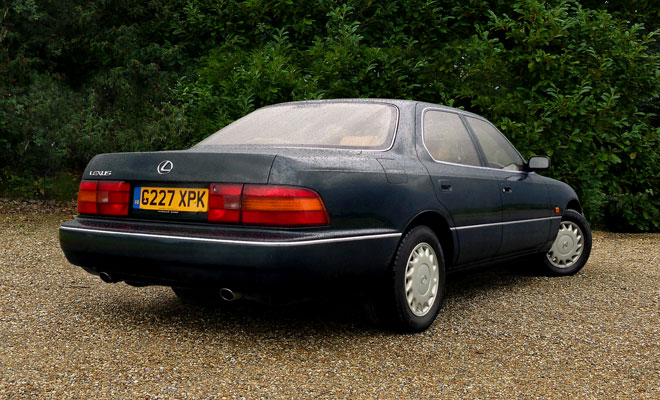by Lem Bingley 
Twenty four years ago this month, in June 1990, Toyota launched its Lexus brand in Europe with a single model in a single specification – the LS 400. Today, Lexus is best known for its upmarket hybrid models like the RX 450h off-roader and GS 450h saloon, but back in 1990 it was known for... well, it wasn’t known for anything at all.
I remember the first Lexus I saw, parked at a roadside in Brighton. I was a penniless student whereas the LS looked a million dollars – sparkling in space-age pearl paint it seemed to squat at the kerb like a freshly landed UFO.
I also recall the impression that the LS was as big and sturdy looking as a tank, but over two dozen years the bodywork seems to have shrunk. Today, the original Lexus seems low, narrow, and as delicate as a quail’s egg. In the intervening years most other cars have steadily become bigger, more aggressively styled and physically tougher than the 1990s breed.
Despite appearances, the LS 400 is still a sizeable beast. At a whisker under 5 metres it’s longer than a modern E-Class or 5-Series, though not quite on a par with today’s 7-Series or S-Class limousines. The modern Lexus LS is about 10cm longer, or a full foot longer in its stretched format.

Overall, the design of the older Lexus has worn well – it’s still a handsome car. Invest in an old LS, a peaked cap and some chauffeur plan insurance and I reckon you could earn a tidy sum in the wedding hire business
The 1990 example I’ve borrowed for a quick spin certainly seems capable of getting blushing brides to the church on time. Despite almost 122,000 miles on the clock it still feels remarkably fresh and solid – though no doubt being owned by Lexus itself helps in this regard. This particular car was one of the first pair to arrive in the UK and starred at the 1990 NEC Motor Show before being sold off, well used, tracked down and reacquired.
Climbing aboard I’m greeted by a Land of Leather whirl of pale upholstery, soft carpets, beige plastic and walnut veneer. The motorised chairs do sag and bounce a little – either through age or because firm support wasn’t deemed luxurious at the time. I slot the key home and the fat wheel immediately whirs down towards my grasp while the high-contrast dials spring up from the depths of their jet black instrument panel.
The engine starts willingly and settles quickly to a barely detectable burble. When the LS was new, it was renowned for being uncannily silent at idle, sufficient to make you forget whether it was running or not. Among the more memorable verdicts on an early LS came from the late LJK Setright, writing in Car Magazine in 1995, who entirely approved of the hush: “In a first class car I no more expect to hear the engine than I should expect to hear the plumbing in a first class hotel.”
Noise does rise on the move – a throaty V8 growl is joined by tyre and wind noise at speed. But it’s still a refined car, even by modern measures.
Of course there’s no fuel-saving electric hybrid system here, just a 4.0-litre petrol V8 designed to produce a lazy 241bhp and 350Nm of torque. Hybrids didn’t figure in the Lexus line-up until 2005. As a result, motorway consumption of around 30mpg plus urban runs of under 20mpg are the order of the day.

The available torque means the LS is no slug – despite its 1.8 tonne weight it could hit 62mph in just 8.3 seconds when new, with a top speed just under 150mph. Today I’m treading a little more gently, letting the four-speed automatic gearbox slide lazily through the gears. There’s also an overdrive button on the leather-wrapped gearstick for relaxed motorway running, plus cruise control of course.
In terms of safety kit there’s a driver’s airbag, ABS brakes and, er, seatbelts. Multiple airbags, stability control and crash avoidance systems still lay firmly in the future when the LS 400 was born.
This keen knowledge, plus a very wet road, vague steering and extremely soft suspension all encourage me to keep well within the limits of grip. Indeed the LS 400 feels happiest when driven as if there’s plenty of time to reach wherever you’re going.
Assessed against modern benchmarks the original LS feels hopelessly loose, lazy and imprecise, more like a boat than a car. But it still possesses a huge reserve of charm, and it’s easy to see how this car provided a firm foothold from which Lexus could expand its sales.
Today, the essence of Lexus has shifted – cars like the IS 300h and GS 450h are as aggressive and sporty as the equivalent BMW or Audi. That’s a shame, in my view. There is still something to be said for the quiet life.

skip to main |
skip to sidebar
Browse by Brand
Most Popular
-
Mercedes-Benz C 220 CDI review – Executive SE edition
-
Audi A1 and A3 to get half an engine
-
Lexus GS 450h review
-
Mild-mannered hybrid: Kia Sportage 48V driven
-
More go for the Twingo: GT edition tested
-
Rising star: Mercedes C220 BlueTec review
-
Family values: Kia Ceed version 3 reviewed
-
Volkswagen e-Golf versus BMW i3
Most Recent
 © 2005 to GreenMotor.co.uk | Contact | Terms & Conditions | Cookies | Privacy | Powered by
© 2005 to GreenMotor.co.uk | Contact | Terms & Conditions | Cookies | Privacy | Powered by  | Close
| Close






